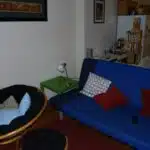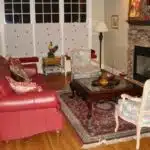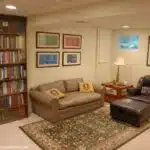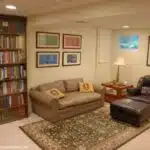Green is a versatile color that can be incorporated into any interior design style. It has the ability to create a calming and refreshing atmosphere while also adding a touch of sophistication and elegance. Decorating with green can be a great way to bring the natural world into your home, creating a sense of harmony and balance.
When it comes to designing with green, there are various shades to choose from, each bringing its own unique character to a space. From deep emerald greens to soft pastels, green can be used as an accent or as the main color in a room. In this article, we will explore the different ways you can decorate with green and offer tips on how to incorporate this color into your home’s décor. Whether you’re looking for bold statement pieces or subtle touches of greenery, we have got you covered.
Understanding The Psychology Of Green
According to a recent study, green is the most restful color for the human eye. It promotes relaxation and has a calming effect on the mind and body. Green is also associated with nature, growth, and renewal. This makes it an excellent choice for interior design as it can provide an overall sense of rejuvenation in any space.
Color associations play a significant role in how we perceive our surroundings. Green is often associated with feelings of freshness, harmony, and balance. It is also linked to good health and well-being, making it a popular choice for healthcare facilities. Decorating with green can help create an atmosphere that promotes healing and calmness.
In addition to its mood-boosting effects, there are many benefits to decorating with green. It can provide a sense of tranquility, promote concentration, and even improve reading ability. Whether used as an accent or as the main color scheme of a room, green has the potential to transform spaces into peaceful sanctuaries that promote relaxation and rejuvenation. In the next section, we will explore how to choose the right shade of green for your space based on your personal preferences and design aesthetic.
Choosing The Right Shade Of Green For Your Space
Light green is a great way to bring a calming, natural atmosphere to a room. It is often used to create a sense of freshness and renewal, and can be easily paired with other cool hues such as blues and purples. Dark green is an excellent choice for those looking to add a moody, rich aesthetic to a space. It can be paired with warm brown tones, or contrasted with lighter shades to truly make a statement. Accent green is an ideal way to introduce a vibrant pop of color to a room. It can be used to add a playful, energizing touch without overwhelming the space, and works well with both cool and warm color palettes.
Light Green
A soft and refreshing shade, light green can create a calming atmosphere in any space. It is a perfect choice for those looking to add a touch of nature to their interior design. Pairing light green with other pastel colors such as pink or lavender can create an elegant and feminine look. The combination of light green and pastels will make your space feel airy and peaceful, perfect for unwinding after a long day.
Using light green as a neutral base for a room’s color scheme is another great way to incorporate this shade into your decor. Light green works well with earthy tones such as beige, brown, and cream. This combination creates a warm and inviting atmosphere that is perfect for living rooms or bedrooms. The use of light green as a neutral base also allows you to be more creative with accent colors, making it an excellent option for those who like to change up their decor frequently.
Incorporating light green into your home decor can bring new life into your space while adding tranquility to the ambiance. Whether you choose to pair it with other pastels or use it as a neutral base, there are endless possibilities when using this soothing hue. So go ahead and experiment with different shades of light green today!
Dark Green
Moving on to another shade of green, dark green can add depth and richness to any space. This hue is perfect for those who want to create a cozy and inviting atmosphere without sacrificing elegance. Dark green pairs well with metallics such as gold or copper, creating a luxe vibe in the room. Mixing metals is a popular trend in interior design, and adding dark green into the mix can take it to the next level.
Layering textures is another way to incorporate dark green into your decor. The combination of different textures such as velvet, linen, and leather can make the space feel more dynamic and interesting. Dark green works well with natural textures such as wood or stone, bringing a touch of nature inside your home. Using darker shades of green in your decor can also create a dramatic effect that adds character to any room.
Whether you prefer light or dark shades of green, incorporating this color into your home decor can bring a sense of calmness and tranquility to your space. From pairing light green with pastels to mixing metals with dark green, there are endless possibilities when it comes to using this versatile hue in your design scheme. So why not experiment with different shades of green today and see how it transforms your living space?
Accent Green
Green accent walls can add a pop of color to any room and create a focal point that draws the eye. When choosing the right shade of green for an accent wall, it’s important to consider the other colors in the room and how they will complement each other. For example, a bold emerald green can pair well with neutral colors such as beige or gray, while a lighter mint green can work well with pastels.
Incorporating green into minimalist design can also be done effectively by using small accents throughout the space. Adding green throw pillows or a vase of fresh flowers can bring life to an otherwise simple and clean design. Another way to incorporate green into minimalist design is by using plants as decor. Not only do they add color and texture to the space, but they also purify the air and promote relaxation.
Overall, incorporating green into your home decor is a great way to bring nature indoors and create a calming atmosphere. Whether you choose to go bold with a green accent wall or incorporate small accents throughout your space, there are endless possibilities when it comes to using this versatile hue in your design scheme. So why not experiment with different shades of green today and see how it transforms your living space?
Creating A Green Color Palette
As we have established, choosing the right shade of green is crucial when decorating with this color. Once you have selected a shade that suits your space and aesthetic preferences, it’s time to think about creating a green color scheme. One way to do this is by matching complementary colors with green.
Green color schemes can be created in various ways depending on the effect you want to achieve. For example, pairing green with other cool colors like blue and purple can create a calming atmosphere, while combining it with warm colors like yellow and orange can add energy and vibrancy to a room. You can also use different shades of green within the same space to create depth and interest.
When selecting complementary colors for your green color scheme, consider using the color wheel as a guide. Colors that are opposite each other on the wheel are considered complementary and tend to work well together. In addition to creating a cohesive look, using complementary colors can also help highlight the beauty of your chosen shade of green.
Using green as an accent color is another excellent way to incorporate this versatile hue into your decor. Whether you opt for small touches like throw pillows or larger statement pieces like an emerald-green sofa or forest-green curtains, adding pops of green can bring life and character into any room. With these tips in mind, you’ll be well on your way to creating a beautiful and harmonious living space that incorporates the many shades and moods of green.
Using Green As An Accent Color
- Incorporating green as an accent color in a room design is a great way to create an eye-catching and inviting atmosphere.
- It is important to think about how to integrate the green hue with complementary colors to create a harmonious effect.
- The shades and intensity of the green should be chosen carefully in order to achieve the desired effect.
- Different shades of green can be used to create a variety of looks, ranging from subtle and sophisticated to bold and eye-catching.
- Accent pieces such as furniture, artwork, and decorations can be used to add green accents to the room.
- The right shade of green can be used to evoke a certain feeling or mood, depending on the desired atmosphere.
Adding Green Accents
Green accents can be a fantastic addition to any room, bringing in a sense of nature and calmness. One way to incorporate green accents is by using green accent placement on furniture or walls. For example, painting an accent wall with a subtle green hue can add depth and character to your space without being overwhelming. Additionally, adding green throw pillows or blankets to a neutral-colored couch can provide an instant pop of color.
If you’re looking for a more hands-on approach, DIY green accents offer endless possibilities. You could create your own terrariums or planters filled with various shades of green foliage as a way to bring the outdoors inside. Another option is to upcycle old glass bottles into beautiful vases that can hold fresh-cut greenery from your garden or local florist. These DIY projects not only add personality and uniqueness to your décor but also allow you to get creative and have fun.
Overall, incorporating green accents into your home décor is an excellent way to create a calming and refreshing atmosphere while adding depth and character to your space. Whether you choose to go with natural greens or DIY projects, there are endless possibilities for incorporating this versatile color into any room of your home. So why not give it a try?
Harmonizing With Green
Green is a versatile color that can be used as an accent to bring life and freshness to any room. In the previous subtopic, we talked about using green accents through DIY projects or by incorporating them into furniture or walls. However, another way to use this color is by harmonizing it with other elements in your space. By creating contrast with green, you can highlight certain features and add depth to your design.
One way to incorporate green in minimalist design is by using it as a grounding color. Since minimalism focuses on simplicity and clean lines, adding a touch of green can provide balance and harmony to your space. For instance, you could use a green area rug or curtains to anchor your furniture pieces and create visual interest without overwhelming the room.
Another way to harmonize with green is by using it as a complementing color. Green pairs well with many colors such as blue, yellow, and gray, so you have plenty of options when choosing accents for your space. For example, you could add green throw pillows to a gray couch or hang artwork with shades of blue and green on a yellow accent wall. These simple touches can create a cohesive look that ties everything together.
In conclusion, harmonizing with green is an excellent way to enhance your interior design while still keeping things simple and minimalistic. Whether you choose to use it as a grounding or complementing color, there are endless possibilities for incorporating this versatile hue into any room of your home. So why not experiment with different shades of green and see how they can transform your space?
Picking The Right Shade
Exploring different shades of green is an essential aspect of using green as an accent color in interior design. Each shade of green has a unique impact on the ambiance of a room, and choosing the right shade can make all the difference. Darker shades of green tend to create a cozy and intimate atmosphere, while lighter shades give off a sense of freshness and vitality. Understanding the impact of lighting on green décor is also crucial, as natural or artificial light can significantly affect how the shade appears in a room.
When selecting a shade of green for your interior design project, it’s important to consider the other colors and elements in the space. The right shade should harmonize with existing colors, adding depth and dimension while still maintaining balance. A good rule of thumb is to use darker shades sparingly as accents, while lighter shades can be used more liberally throughout the room.
Another factor to consider when picking the right shade of green is the mood you want to create in your space. For instance, if you’re looking for a calming and serene environment, then pale greens like mint or sage are ideal choices. Conversely, if you want to inject energy into your space, brighter greens like lime or chartreuse can do just that. Ultimately, exploring different shades of green and experimenting with how they interact with various lighting conditions and decor styles will help you find the perfect hue for your next interior design project.
Incorporating Green Through Textiles
Green is a symbol of growth and renewal, making it a perfect choice for home decor. Incorporating green through textiles can be an easy way to add this refreshing color to a room. Using green accents can create a cohesive design scheme that ties the room together.
When choosing green textiles, consider the texture and pattern of the fabric. Adding a plush emerald green throw blanket or a set of leafy green pillows can add depth and visual interest to a space. A botanical print curtain or a striped rug with shades of green can also be great options.
To create an even more impactful look, try layering different shades of green throughout the room. This can be achieved by mixing and matching different textures and patterns, such as combining a velvet emerald green sofa with sage green linen curtains.
Incorporating green through textiles is just one way to bring this vibrant color into your home. In the next section, we will explore how adding green with art and accessories can further enhance your space.
Adding Green With Art And Accessories
Green is a versatile and popular color in interior design, and incorporating it through textiles is just one way to bring this calming hue into your home. However, there are many other options available for adding green to your decor. One of these is through green wall art, which can serve as a focal point for a room or provide a subtle touch of color.
Green wall art comes in many forms, from abstract paintings to nature-inspired prints. When selecting pieces for your home, consider the overall tone of the room and the mood you want to create. Brighter greens can energize a space, while muted shades can add a sense of calmness. Additionally, be mindful of how the artwork will coordinate with other elements in the room, such as furniture and accent pieces.
Another way to incorporate green into your decor is through decorative accessories. This includes items such as throw pillows, vases, and candles. These small touches can have a big impact on the overall look and feel of a room. When choosing green accessories, consider the texture and visual interest they bring to the space. For example, an emerald velvet pillow will add richness and depth to a neutral sofa.
Incorporating green into your decor doesn’t have to be limited to textiles and accessories. The next section will explore how decorating with green plants can bring life and vibrancy into any space.
Decorating With Green Plants
The color green is often associated with nature, growth, and vitality. One way to incorporate this color into your home decor is by adding green plants. Not only do they provide a pop of color, but they also have numerous health benefits such as improving air quality and reducing stress levels.
When it comes to decorating with green plants, it’s important to consider their care requirements. Different types of plants have different needs in terms of sunlight, water, and soil type. It’s crucial to research the specific care instructions for each plant before incorporating them into your home decor. Additionally, make sure to place plants in areas that receive adequate sunlight and are not too hot or cold.
Green plant placement is also an important aspect to consider when decorating with plants. Placing a tall plant in a corner can add height and dimension to a room while hanging smaller plants from the ceiling can create a unique focal point. Another idea is to group several small plants together on a windowsill or shelf for added visual interest.
Next up: creating a green wall without breaking the bank!
Creating A Green Wall
One of the most popular ways to incorporate green into your home décor is by creating a green wall. Also known as a vertical garden, this type of installation can add an element of nature and freshness to any room. A green wall is essentially a collection of plants that grow vertically on a support structure attached to a wall. These structures can be made from various materials such as wood, metal, or plastic.
Creating a green wall in your home can be achieved in different ways depending on the space available and the type of plants you want to use. One option is to purchase pre-made planters specially designed for wall installations, which can be hung on brackets or rails. Another option is to create your own custom design using individual plant pots arranged in a pattern on the wall. For those who want something more artistic, plant wall art is also becoming increasingly popular, with artists creating unique designs using different types of plants and arrangements.
A green wall not only adds beauty and texture to your space but also has health benefits such as improving air quality and reducing stress levels. Moreover, it can serve as an excellent backdrop for other decorative elements in your room like artwork or lighting fixtures. In the next section, we will explore how incorporating green through lighting can further enhance your home’s ambiance and aesthetic appeal.
Incorporating Green Through Lighting
Some people may be hesitant to incorporate green lighting into their homes due to concerns about energy consumption and environmental impact. However, there are many eco-friendly lighting options available that can still provide a beautiful and stylish addition to any home decor.
One great way to incorporate green into your lighting is through the use of LED bulbs. Not only are they energy-efficient, but they also emit less heat than traditional bulbs, making them safer for use in a variety of fixtures. Additionally, you can choose from a range of color temperatures to create the perfect ambiance in any room.
Another option for adding green through lighting is to incorporate natural materials such as bamboo or wood into your fixtures. These materials not only look beautiful but are also sustainable choices that will last for years to come. You can also consider using shades or covers made from recycled materials to further reduce your environmental impact.
As you can see, there are many green lighting ideas available that can help you create a beautiful and sustainable home design. By choosing eco-friendly options such as LED bulbs and natural materials, you can enjoy the benefits of stylish and energy-efficient lighting while reducing your carbon footprint. In the next section, we will explore how to incorporate green through furniture and upholstery.
Using Green In Furniture And Upholstery
Green furniture can be a bold statement in any room. It can add a pop of color or create a calming atmosphere depending on the shade used. When selecting green furniture, it is essential to consider the other colors in the room and how they will complement each other.
One idea for incorporating green into your furniture is by choosing a statement piece such as a sofa or armchair. This method allows for flexibility in the rest of the room since you can choose complementary neutral accessories and accents. Another option is using green ottomans or benches as accent pieces to add pops of color throughout the room.
Upholstery ideas are also an excellent way to incorporate green into your decor while adding texture and dimension. Consider using green velvet upholstery on chairs, sofas, or headboards for a luxurious look. Alternatively, use printed green fabrics on accent chairs or throw pillows to add visual interest. The possibilities are endless when it comes to adding green through upholstery choices.
To continue incorporating green into your home, consider adding it to your kitchen design. There are several ways to do this, from painting cabinets to incorporating plants and herbs into open shelving displays. Adding natural elements such as wood and stone with pops of green accents can create an inviting and earthy feel in the heart of your home.
Adding Green To The Kitchen
Green is a color that symbolizes harmony, balance, and growth. Incorporating green into the kitchen can create a refreshing and calming ambiance. One way to add green to your kitchen is by installing green kitchen cabinets. Green cabinetry can make a bold statement in your kitchen while still remaining timeless. Pairing green cabinets with neutral shades like white or beige can create an elegant and sophisticated look.
Another way to add green to your kitchen is by accenting with green backsplash tiles. Backsplash tiles are an excellent way to introduce color and texture into your space without being too overpowering. Green tiles can add a pop of color to an otherwise monochromatic kitchen design. They are also easy to clean, making them perfect for use behind stovetops and sinks where splatter marks tend to accumulate.
Incorporating green into your kitchen design doesn’t have to be overwhelming or complicated. Simple additions like green cabinetry or backsplash tiles can transform your space into a peaceful oasis that promotes relaxation and creativity. With these tips in mind, let’s explore how you can decorate with green in the bathroom.
Decorating With Green In The Bathroom
Green is a great color to incorporate into bathroom decor. It brings a sense of tranquility and calmness to the space. One way to bring in green is through the use of green bathroom tiles. These tiles can be used on the floor or as an accent wall, adding a pop of color and texture to the room.
In addition to using green bathroom tiles, there are other sustainable bathroom decor options that can bring in touches of green. For example, using bamboo or reclaimed wood for shelving and accessories can add an earthy vibe to the space. Another option is incorporating plants into the bathroom design, such as hanging ferns or succulents on windowsills or shelves.
To tie everything together in your green-themed bathroom, consider these three tips:
- Use neutral colors like white or beige for walls and major fixtures, allowing your green accents to stand out.
- Mix different shades of green throughout the space for added depth and dimension.
- Add natural textures like woven baskets or jute rugs for an organic feel.
Overall, creating a sustainable and stylish green-themed bathroom is easy when you incorporate elements like green tiles, natural materials, and plants. The next step? Bringing this same aesthetic into kids’ rooms!
Using Green In Kids’ Rooms
When it comes to decorating kids’ rooms, green is a versatile and playful color choice. One way to incorporate green into the room is through the use of green wallpaper. Wallpaper with a fun pattern or design can add interest and depth to the space, while still maintaining a cohesive look. It also allows for flexibility in furniture and accessory choices.
Another option is to create a green accent wall. This can be achieved by painting one wall in the room a shade of green that complements the existing decor. A bold and bright green can make a statement, while a softer pastel shade can create a calming atmosphere. The accent wall can also serve as a focal point for the room, drawing the eye towards it and highlighting any artwork or decorations placed on it.
In addition to wallpaper and accent walls, incorporating pops of green throughout the room is an easy way to add some color without overwhelming the space. Green throw pillows, rugs, curtains, and bedding are all simple yet effective ways to bring in this vibrant hue. Mixing different shades of green together can also create visual interest and depth in the room. By incorporating these various elements, you can create a fun and inviting space that your child will love spending time in.
Transitioning into decorating with green in small spaces: Incorporating green into small spaces may seem like a challenge at first glance, but with careful consideration of shades and placement, it can actually make the space appear larger. In the following section, we will explore various ways to use green effectively in smaller rooms or apartments.
Decorating With Green In Small Spaces
Green is a versatile color that can add life and energy to any space. In the previous section, we explored how green can be used in kids’ rooms. Now, let’s take a look at how you can decorate small spaces with green.
When it comes to small spaces, maximizing greenery is key. Plants not only add a pop of color but also purify the air and create a calm atmosphere. Hanging plants or wall-mounted planters are great options for adding greenery without taking up precious floor space. You can also consider placing potted plants on shelves or using them as centerpieces on tables.
Another way to incorporate green into your small space is through Green inspired DIY projects. For example, you can make your own terrariums or create artwork featuring leaves or botanical prints. These projects not only add a personal touch to your décor but also allow you to customize the shade of green that best suits your style.
Incorporating green into your small space doesn’t have to be overwhelming or expensive. By maximizing greenery and exploring Green inspired DIY projects, you can easily bring the outdoors inside and create a fresh and inviting atmosphere. In the next section, we will discuss tips for coordinating different shades of green within your décor to pull it all together seamlessly.
Pulling It All Together: Tips For Coordinating Green Décor
When it comes to coordinating green décor, there are a few tips that can help you pull it all together. One way is to mix patterns that incorporate various shades of green. For example, pairing a green plaid pillow with a floral cushion in similar shades can add depth and interest to your space. Another option is to layer different textures, such as placing a velvet green throw over a woven chair or incorporating plants into your décor.
Another aspect to consider when coordinating green décor is the use of metallics. Adding touches of gold or silver can elevate the look and add glamour to your space. For instance, hanging gold-framed artwork on a wall painted in a deep green hue creates an elegant and sophisticated ambiance. Furthermore, incorporating metallic accents in your accessories like vases or candle holders will create contrast against the natural tones of green.
Overall, mixing patterns and incorporating metallics are two effective ways for pulling together your green décor. By doing so, you can create a cohesive look that showcases the beauty and versatility of this color. Remember to experiment with different combinations until you find the right balance for your taste and style.
Conclusion
The use of green in interior design is a popular choice for many reasons. It’s a versatile color that can evoke feelings of calmness, relaxation, and growth. When choosing the right shade of green for your space, it’s important to consider the psychology behind each hue and how it will interact with other colors in your palette. Utilizing green as an accent color or incorporating it through textiles are great ways to add life to any room.
Incorporating green into a bathroom can create a spa-like atmosphere, while using it in a kids’ room can stimulate creativity and imagination. Even small spaces can benefit from green accents, such as plants or wall art. With these tips and tricks in mind, coordinating a cohesive green décor is achievable.
Overall, decorating with green can bring an element of nature into your home while also creating a sense of tranquility and balance. Whether you’re looking to refresh a room or redecorate your entire space, incorporating shades of green is sure to bring life and freshness into your home. By understanding the psychological effects of different greens and utilizing them strategically throughout your space, you’ll be able to achieve the perfect balance of style and serenity.
Image Credits
- “Green Day Concert Crowd – Put Your Hands Up For Green Day” by Anirudh Koul (featured)




























